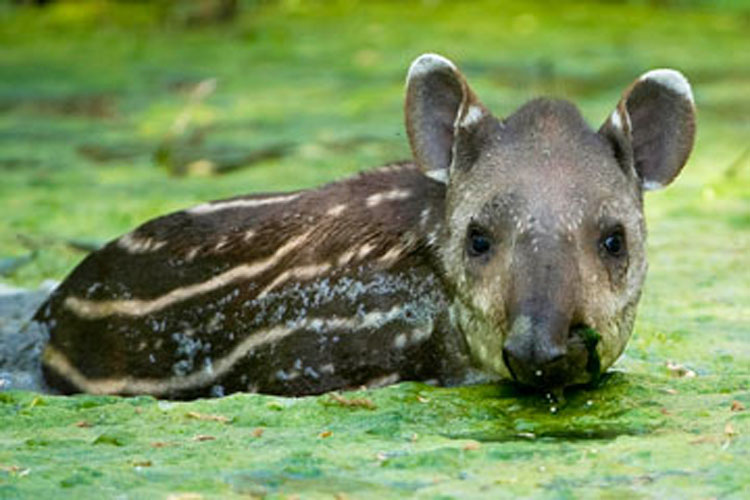 ::cck::152::/cck::
::cck::152::/cck::
::introtext::
Since October 1996, Patrícia Medici, a senior researcher and co-founder of IPÊ, has been undertaking a research and conservation program focused on the Brazilian tapir in the Atlantic Forests of the Pontal do Paranapanema Region (Teodoro Sampaio, São Paulo State). This region includes Morro do Diabo State Park, a forested area of 35,000 hectares and one of the last significant remnants of interior Atlantic Forest, and other surrounding forest fragments totaling 12,000 hectares. The Brazilian Atlantic Forest is one of the most threatened biomes in the world; its original area was of 1,300,000km² (12% of Brazil’s area). However, today, this has been reduced to approximately 7% of the original size.
::/introtext::
::fulltext::
From 1996 to 2007, this long-term project has focused on the wild tapir populations in the Pontal region. Thirty five tapirs were captured during this period, twenty-five of these (13 females and 12 males) were fitted with radio-telemetry collars and monitored during several years. This yielded data of individual home ranges, core areas of use, home range overlaps between neighboring individuals, social organization, seasonal use of habitat types, and dispersal through the fragmented landscape. Hundreds of biological samples were collected, generating data on the genetic and epidemiological status of the species as well as feeding ecology and seed dispersal.
IPÊ’s Atlantic Forest Tapir Program was the first long-term conservation initiative for tapirs in Brazil and yielded a database of information about the status of the species in the Atlantic Forests of the Pontal do Paranapanema. The primary focus of the Program was landscape ecology. Tapirs were used as “ecological detectives” to identify and map the primary dispersal routes through the region and, consequently, the most effective areas for the establishment of forest corridors and stepping stones. IPÊ used these data to influence the forest restoration process in the region and promote the creation of new protected areas. Importantly, this information was used to develop a Regional Action Plan for the Research, Conservation and Management of the Brazilian Tapir in the Atlantic Forest, a set of priority strategies that is currently under implementation.
Since 2008, with the expansion of tapir conservation efforts to other Brazilian biomes and the establishment of the Lowland Tapir Conservation Initiative, the Atlantic Forest Tapir Program has expanded into a long term monitoring program. Some relevant population variables (population size, demography, epidemiology and genetics) will continue to be monitored in Morro do Diabo State Park during the next ten years in order to detect changes that may require intervention from conservationists
Visit the Pantanal Tapir Program and the Hotsite of the Lowland Tapir Conservation Initiative at www.tapirconservation.org.br
::/fulltext::
::ac_acordeon::4::/ac_acordeon::
::cck_ac_acordeon::acordeon::/cck_ac_acordeon::
::ac_titulo_acordeon|0|ac_acordeon::Basic information::/ac_titulo_acordeon|0|ac_acordeon::
::ac_texto_acordeon|0|ac_acordeon::
The families Tapiridae, Equidae and Rhinocerotidae form the order Perissodactyla. There are four tapir species: T. terrestris, T. bairdii, T. pinchaque (Central and South America) and T. indicus (Southeast Asia). Although the Brazilian tapir is distributed widely, from northern Colombia east of the Andes southward into all of tropical South America, it is classified by the IUCN Red List (2011) as Vulnerable to Extinction and included in Appendix II of CITES. The species occurs primarily in lowland tropical forests but can also be found in drier habitats such as the Bolivian and Paraguayan Chaco.
Tapirs play important roles in biodiversity dynamics. They are indicators of ecosystem health and critical for key ecological processes such as seed predation and dispersal and nutrient cycling. Tapirs are recognized as a “landscape species” and can partly define the interactions that exist within the landscape, identifying the importance of protecting mosaics of different habitat types, for example.
The Brazilian tapir is threatened primarily by habitat destruction and hunting. Both threats reduce and isolate populations in various parts of the species’ distribution. Small population sizes resulting from isolation exposes these animals to demographic, genetic and environmental pressures that drastically increase the chance of local extinctions. Population declines and local extinctions can have adverse effects on ecosystems, affecting ecological processes and eventually compromising the integrity and biodiversity of these ecosystems. The effects of small population sizes and isolation are exacerbated by the intrinsically low reproductive rate of the species; sexual maturity begins at four years, gestation lasts thirteen months, there is generally a single offspring and the interval between births is two years. As a consequence, recuperation of pressured populations is very slow.
Because the their important role in the maintenance of biological diversity, their recognition as “landscape species” and their threatened conservation status, it is necessary that we keep in mind the urgent need to establish conservation efforts for the species to implement research, conservation n and management programs for the Brazilian tapir in all biomes where the species occurs.
For more information on the four tapir species, please visit the website of the Tapir Specialist Group of the Species Survival Commission, IUCN – International Union for Conservation of Nature: www.tapirs.org
::/ac_texto_acordeon|0|ac_acordeon::
::cckend_ac_acordeon::::/cckend_ac_acordeon::
::cck_ac_acordeon::acordeon::/cck_ac_acordeon::
::ac_titulo_acordeon|1|ac_acordeon::Current and Future Objectives of the Atlantic Forest Tapir Program::/ac_titulo_acordeon|1|ac_acordeon::
::ac_texto_acordeon|1|ac_acordeon::
Continue demographic, density, population size (and its fluctuations), epidemiology and genetic monitoring of tapirs in Morro do Diabo State Park.Implement the Regional Action Plan for Research, Conservation and Management of the Brazilian Tapir in the Atlantic Forest of the Pontal do Paranapanema, São Paulo.Contribute data and information for the creation of private reserves and other protected areas comprised of priority conservation areas for the Brazilian tapir in the Pontal do Paranapanema.
- Continue demographic, density, population size (and its fluctuations), epidemiology and genetic monitoring of tapirs in Morro do Diabo State Park.
- Implement the Regional Action Plan for Research, Conservation and Management of the Brazilian Tapir in the Atlantic Forest of the Pontal do Paranapanema, São Paulo.
- Contribute data and information for the creation of private reserves and other protected areas comprised of priority conservation areas for the Brazilian tapir in the Pontal do Paranapanema.
- Implement an Experimental Program of Reintroduction and Translocation of the Brazilian Tapir in the Pontal do Paranapanema.
Coordinator: Patrícia Medici
M.Sc. in Ecology, Conservation and Wildlife Management
Ph.D., Biodiversity Management, DICE, University of Kent, UK
Coordinator, National Initiative for the Conservation of the Brazilian Tapir
President, IUCN/SSC Tapir Specialist Group (TSG)
E-mail: epmedici@uol.com.br ou medici@ipe.org.br
::/ac_texto_acordeon|1|ac_acordeon::
::cckend_ac_acordeon::::/cckend_ac_acordeon::
::cck_ac_acordeon::acordeon::/cck_ac_acordeon::
::ac_titulo_acordeon|2|ac_acordeon::Partners (1996-2007)::/ac_titulo_acordeon|2|ac_acordeon::
::ac_texto_acordeon|2|ac_acordeon::
Institutional Support
- Association of Zoos and Aquariums (AZA) Tapir Taxon Advisory Group (TAG)
- Copenhagen Zoo, Dinamarca
- European Association of Zoos & Aquaria (EAZA) Tapir Taxon Advisory Group (TAG)
- Faculdade de Veterinária, Universidade de São Paulo (USP), São Paulo, Brasil
- Houston Zoo Inc., EUA
- IBAMA SISBIO, Brasil
- Instituto Florestal de São Paulo, Parque Estadual Morro do Diabo, São Paulo, Brasil
- IUCN/SSC Tapir Specialist Group (TSG)
- IUCN/SSC Conservation Breeding Specialist Group (CBSG)
- WildTrack, Portugal
- World Association of Zoos and Aquariums (WAZA), Suíça
- Zoológico de Sorocaba, São Paulo, Brasil
Financial/In-Kind Support
- American Association of Zoo Keepers (AAZK), Houston Zoo
- American Association of Zoo Keepers (AAZK), Los Angeles Zoo
- American Association of Zoo Keepers (AAZK), Nashville Zoo
- American Association of Zoo Keepers (AAZK), Puget Sound
- Association of Zoos & Aquariums (AZA) Tapir Taxon Advisory Group (TAG)
- Chester Zoo, North of England Zoological Society, Inglaterra
- Chicago Zoological Society, Brookfield Zoo, EUA
- Cleveland Metroparks Zoo, EUA
- Columbus Zoological Park Association Inc., EUA
- Copenhagen Zoo, Dinamarca
- Disney Worldwide Conservation Fund, EUA
- Disney Worldwide Conservation Fund – Emergency Fund, EUA
- Dutch Zoos Conservation Fund, Holanda
- European Association of Zoos & Aquaria (EAZA) Tapir Taxon Advisory Group (TAG)
- FNMA – Fundo Nacional do Meio Ambiente, Brasil
- Givskud Zoo, Dinamarca
- Houston Zoo Inc., EUA
- Idea Wild, EUA
- IUCN/SSC Tapir Specialist Group Conservation Fund (TSGCF)
- IUCN Small Grants Programme, The Ford Foundation, EUA
- John Ball Zoo Society, Wildlife Conservation Fund, EUA
- Lincoln Park Zoo, Scott Neotropical Fund, EUA
- Nellcor Inc., EUA
- Oregon Zoo Foundation Conservation Fund, EUA
- Parc Zoologique d’Amnéville, França
- Parc Zoologique Doué-la-Fontaine, França
- Smithsonian Institution, Wildlife Conservation & Management Training Program (WCMTP), EUA
- Sophie Danforth Fund, Roger Williams Park Zoo, EUA
- Tapir Preservation Fund (TPF), EUA
- The Ledder Family Charitable Trust, EUA
- Woodland Park Zoological Gardens, EUA
Private Donations (1996-2007)
- Alex & Suzan Sze
- Alex Cardenas
- Andre Maerz
- Andy Markley
- Andy Schultz
- Ayessa Rourke
- Brandie Smith
- Brenda Stringer
- Carol & Mark Reid
- Charles R. Foerster
- Christine Kim & Rob Lyman
- Corinna Bechko & Gabriel Hardman
- Corinne Kendall
- Darin Collins
- Deanne Holsworth
- Diego Orlando
- Diane Ledder
- Discovery Channel Canada
- Elaine & Paul Beckham
- Gilia Angell & Aaron Abrams
- Heidi Frohring
- Kae Kawanishi
- Katalin Pinter & Christian Fabris
- Keith Sproule
- Kelly Russo
- Kevin Burkhill
- Kristin Leus
- Leonardo Salas
- Michael & Donna Dee
- Mickael Michault
- Mitch Finnegan
- Morty Ortega
- Phil Coleman
- Phil Schaeffer
- Rick Barongi
- Sharon Matola
- Sheryl Todd
- William Bob Harris
::/ac_texto_acordeon|2|ac_acordeon::
::cckend_ac_acordeon::::/cckend_ac_acordeon::
::cck_ac_acordeon::acordeon::/cck_ac_acordeon::
::ac_titulo_acordeon|3|ac_acordeon::Important Links::/ac_titulo_acordeon|3|ac_acordeon::
::ac_texto_acordeon|3|ac_acordeon::
Hotsite Anta
www.tapirconservation.org.br
Facebook Patrícia Medici Personal Profile
www.facebook.com/patricia.medici?ref=profile
Facebook Lowland Tapir Conservation Initiative CAUSE
www.causes.com/causes/292707?m=0d43bb06
Canal You Tube Iniciativa Nacional para a Conservação da Anta Brasileira
www.youtube.com/patriciamedici
IUCN/SSC Tapir Specialist Group (TSG)
www.tapirs.org
IUCN Red List Lowland Tapirs
www.iucnredlist.org/apps/redlist/details/21474/0
WAZA Tapir Profile
::/ac_texto_acordeon|3|ac_acordeon::
::cckend_ac_acordeon::::/cckend_ac_acordeon::
::ac_arquivos::1::/ac_arquivos::
::cck_ac_arquivos::arquivo::/cck_ac_arquivos::
::ac_titulo_arquivo|0|ac_arquivos::::/ac_titulo_arquivo|0|ac_arquivos::
::ac_arquivo|0|ac_arquivos::::/ac_arquivo|0|ac_arquivos::
::cckend_ac_arquivos::::/cckend_ac_arquivos::
::ac_galeria::1::/ac_galeria::
::cck_ac_galeria::galeria::/cck_ac_galeria::
::ac_foto_descricao|0|ac_galeria::::/ac_foto_descricao|0|ac_galeria::
::ac_foto|0|ac_galeria::::/ac_foto|0|ac_galeria::
::cckend_ac_galeria::::/cckend_ac_galeria::


